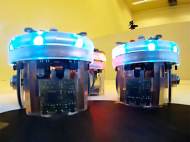Learning about visual communication from robots
 A joint research project conducted at University of Lausanne (UNIL) and EPFL performed a research that could lead to better understanding of communication within the animal kingdom. They followed the evolution of communication in 100 groups of 20 robots over the course of 1000 generations. The results show that communication systems can evolve differently within the same species and even the same environment.
A joint research project conducted at University of Lausanne (UNIL) and EPFL performed a research that could lead to better understanding of communication within the animal kingdom. They followed the evolution of communication in 100 groups of 20 robots over the course of 1000 generations. The results show that communication systems can evolve differently within the same species and even the same environment.
Led by Laurent Keller from UNIL and by Steffen Wischmann and Dario Floreano from EPFL, the initial experiment of the research showed that the robots rapidly acquire a communication system that enables them to transmit information about the location of the food to their peers. In fact, two really distinct communication systems evolved, according to the given populations.
The robots are equipped with a camera used to detect the environment, as well as a ring enabling them to emit luminous signals of different colors. Positioned in arenas, their goal was to move around in order to locate a source of virtual food that is detectable only when they stumbled upon it. Their behavior was guided by a “neural network”, which was also controlled by genes that could evolve through mutation and selection in the course of successive generations.
The results of their experiments shown that once a population evolves towards a relatively effective type of communication, it doesn’t make drastic changes through generations and it demonstrated the importance of random factors in evolutionary processes. The experiment performed in twenty homogenous groups (with robots of the same type) actually shows that half of them choose the simpler strategy, whereas the rest opts for the two color system.
In experiments where a certain version of a “language” was tested, the results show that the simpler mechanism, where robots use a single color to indicate the location of the food, proved more effective that the system using two colors where robots used one side of their multicolored ring of light to pointing towards the food and the other towards the remaining part of the arena. In a second experiment where groups of robots were confronted in a robots competition context with robots of other populations, the more complex (two-color) strategy that won the day, in spite of the proven effectiveness of the single-color strategy.
“We know that in the animal kingdom communication systems are very complex”, said Keller, Professor at UNIL’s Department of Ecology and Evolution. “And this diversity evolved over a very long period of time. Our experiment shows how it occurs, and reveals that environmental factors are not the only ones involved, as one might believe. The robots shed new light on these evolutionary processes.”
For more information, you can read the full paper in the magazine PNAS (Proceedings of the National Academy of Sciences of the United States): “Historical contingency affects signaling strategies and competitive abilities in evolving populations of simulated robots”.









Leave your response!